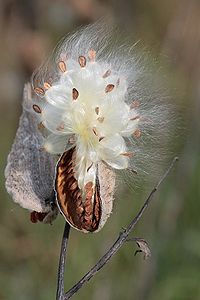
Follicle (fruit)
Encyclopedia

Fruit
In broad terms, a fruit is a structure of a plant that contains its seeds.The term has different meanings dependent on context. In non-technical usage, such as food preparation, fruit normally means the fleshy seed-associated structures of certain plants that are sweet and edible in the raw state,...
formed from one carpel and dehiscing
Dehiscence (botany)
Dehiscence is the opening, at maturity, in a pre-defined way, of a plant structure, such as a fruit, anther, or sporangium, to release its contents. Sometimes this involves the complete detachment of a part. Structures that open in this way are said to be dehiscent...
by the ventral suture in order to release seeds, such as in larkspur
Larkspur
Larkspur may refer to:* Larkspur, California* Larkspur, Colorado* Larkspur radio system, used by the British Army* Delphinium, a genus of 300 flowers with widespread nativity* Consolida, a genus of 40 flowers native to central and western Eurasia...
, magnolia
Magnolia
Magnolia is a large genus of about 210 flowering plant species in the subfamily Magnolioideae of the family Magnoliaceae. It is named after French botanist Pierre Magnol....
, banksia
Banksia
Banksia is a genus of around 170 species in the plant family Proteaceae. These Australian wildflowers and popular garden plants are easily recognised by their characteristic flower spikes and fruiting "cones" and heads. When it comes to size, banksias range from prostrate woody shrubs to trees up...
, peony
Peony
Peony or paeony is a name for plants in the genus Paeonia, the only genus in the flowering plant family Paeoniaceae. They are native to Asia, southern Europe and western North America...
and milkweed.
It is rare to meet with a solitary follicle forming the fruit. There are usually several aggregated together, either in a whorl on a shortened receptacle, as in hellebore
Hellebore
Commonly known as hellebores, members of the genus Helleborus comprise approximately 20 species of herbaceous perennial flowering plants in the family Ranunculaceae, within which it gave its name to the tribe of Helleboreae...
, aconite
Aconite
Aconite may refer to:*Aconitum, a plant genus containing the monkshoods*Aconitine, "the queen of poisons", a toxin derived from some of the Aconitum genus plants*Winter aconite, a plant in the genus Eranthis...
, larkspur
Larkspur
Larkspur may refer to:* Larkspur, California* Larkspur, Colorado* Larkspur radio system, used by the British Army* Delphinium, a genus of 300 flowers with widespread nativity* Consolida, a genus of 40 flowers native to central and western Eurasia...
, columbine
Aquilegia
Aquilegia is a genus of about 60-70 species of perennial plants that are found in meadows, woodlands, and at higher altitudes throughout the Northern Hemisphere, known for the spurred petals of their flowers.-Etymology:The genus name Aquilegia is derived from the Latin word for eagle , because...
or the family Crassulaceae
Crassulaceae
Crassulaceae, or the orpine family, are a family of dicotyledons. They store water in their succulent leaves. They are found worldwide, but mostly occur in the Northern Hemisphere and southern Africa, typically in dry and/or cold areas where water may be scarce...
, or in a spiral manner on an elongated receptacle, as in Magnolia
Magnolia
Magnolia is a large genus of about 210 flowering plant species in the subfamily Magnolioideae of the family Magnoliaceae. It is named after French botanist Pierre Magnol....
and Banksia
Banksia
Banksia is a genus of around 170 species in the plant family Proteaceae. These Australian wildflowers and popular garden plants are easily recognised by their characteristic flower spikes and fruiting "cones" and heads. When it comes to size, banksias range from prostrate woody shrubs to trees up...
. Occasionally, follicles dehisce by the dorsal suture, as in Magnolia grandiflora and Banksia.

